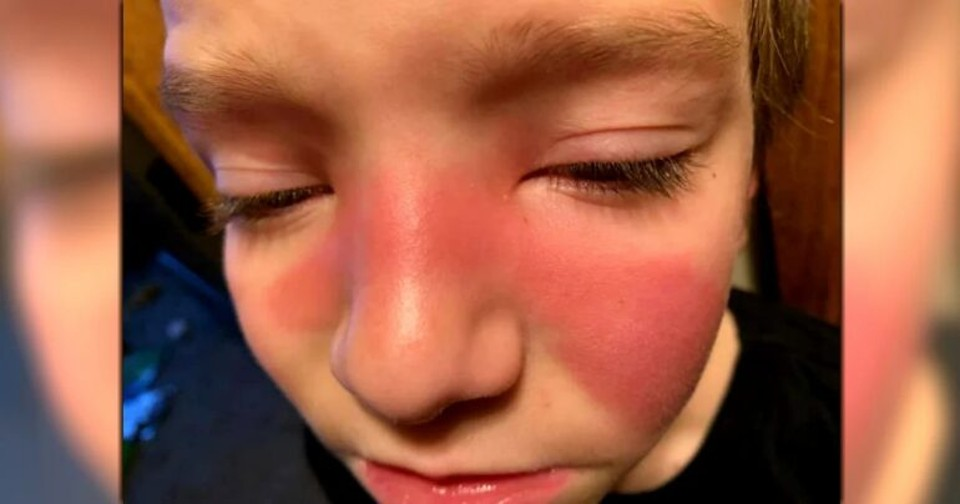Imagine sending your child out to play, only to have them come back with a mysterious red mark on their face. For any parent, the immediate thought would likely be a minor bump or bruise. But for one Idaho mother, that red mark led to a heart-stopping rush to the hospital. This is a story of a seemingly innocent incident that turned into a medical emergency, and it serves as a crucial reminder to parents everywhere.
During flu season, it’s common for children to pick up illnesses that seem harmless at first glance. But as more parents are sharing their experiences, we’re learning that some symptoms, like unusual red marks, can signal something much more serious. This article will explore one such story of a young boy whose red mark turned out to be a strep infection, and why parents should pay attention to similar signs.

The Mysterious Red Mark on Coop’s Face
It all started when Coop, a teenager from Idaho, was playing with his younger sibling. He cried out, saying he’d been hit on the nose. His parents, Arden and Ashlee Hawley, initially suspected it was just a small bump from his younger sibling’s playful behavior. However, they soon realized something was wrong when the red mark on Coop’s face began to worsen instead of heal.
Concerned, they took Coop to the doctor, who prescribed steroids. But despite the medication, the mark continued to get worse. The Hawleys, now growing alarmed, rushed their son to the emergency room. That’s where doctors discovered that the red mark on Coop’s face wasn’t just an ordinary bruise—it was actually the result of a strep infection in his sinuses.
Understanding Strep Infections Beyond the Throat
Most of us associate strep infections with sore throats, but Coop’s case was far more complicated. What many don’t realize is that there are more than 20 types of strep bacteria, each capable of affecting different parts of the body. While strep throat is the most common, strep infections can manifest in other areas, such as the skin, sinuses, or even the eyes and brain.
Had Coop’s parents waited any longer, the infection could have spread to his eyes or brain, causing potentially life-threatening complications. Fortunately, he was treated in time, and after receiving medical care, Coop was able to return home to recover. However, the Hawleys were left with a strong sense of responsibility—they knew they had to warn other parents about how serious an unidentified red mark can be.
A Similar Story: Another Mother’s Experience with Red Marks
Coop’s case isn’t an isolated one. Another mother, who chose to remain anonymous, shared a similar story on the parenting website Simply Real Moms. Her son had developed flu-like symptoms, including a high fever and strange red marks on his face. Like Coop’s mom, she initially thought it might be nothing more than a rash from the fever. However, by the next day, her son’s temperature had spiked to 102 degrees, even while on medication.
When she rushed him to the emergency room, doctors diagnosed him with both the flu and strep throat. The unusual red marks on his face were actually a sign of the strep infection spreading.
“I had no idea that strep could show up like this,” the mother admitted. “I feel compelled to inform other parents about these unidentified signs.” Her message? Don’t take unusual marks or rashes lightly—what might seem minor could actually be a warning sign of something more serious.

The Danger of Untreated Strep Infections
As flu season continues to sweep across the United States, stories like these are becoming increasingly common. In another case, Candace Reeves McMahan, an Oklahoma mother, shared her experience after her son, Luke, developed a severe strep infection. Initially, Luke only had a red, puffy face and flu-like symptoms, but the infection quickly spread, affecting his eyes and threatening to reach his brain.
Candace rushed Luke to the hospital, where doctors immediately performed surgery to prevent the infection from spreading further. The situation was terrifying—Candace described how close the infection had come to affecting Luke’s brain—but thankfully, the surgery was successful, and Luke made a full recovery.
Like the other parents, Candace is now warning others. “It was really close to the brain, which is super alarming!” she said. “If the diagnosis had been done sooner, this could have been avoided.”

How to Recognize Dangerous Symptoms in Children
So, what can parents take away from these stories? The most important lesson is that unusual marks or rashes on your child’s face, especially during flu season, shouldn’t be ignored. Strep infections don’t always present themselves in the throat, and a red mark could be the first sign of a serious issue.
Here are some signs to watch for if your child shows flu-like symptoms:
- High fever (especially if it persists even with medication)
- Red or swollen areas on the face, particularly around the eyes and nose
- Rashes or red marks that don’t fade or worsen over time
- Unexplained swelling or puffiness
If you notice any of these symptoms, especially combined with a high fever, it’s best to seek medical attention immediately. Early diagnosis can prevent the infection from spreading to more dangerous areas, like the eyes or brain.
The Importance of Sharing Stories Like These

It’s easy to dismiss a small mark or rash as something minor, but these families’ stories remind us that being cautious can make all the difference. Thanks to their courage in sharing their experiences, parents everywhere are now more aware of the potential dangers during flu season.
Coop’s family, along with the other parents, are proof that taking quick action can prevent serious complications. Whether it’s a red mark on the nose, a high fever, or unusual swelling, being proactive and seeking medical care can protect your child from potentially life-threatening infections.
Conclusion: Trust Your Instincts and Act Quickly
As flu season rages on, stories like Coop’s are a valuable reminder that not all symptoms are what they seem. A mysterious red mark on your child’s face could be more than just a bump—it could be a warning sign of something far more serious.
Parents know their children best, so trust your instincts. If something doesn’t seem right, don’t hesitate to take action. Thanks to early intervention, Coop, Luke, and the other children in these stories were able to recover. These tales serve as a crucial lesson for all parents: never ignore a red flag when it comes to your child’s health.


